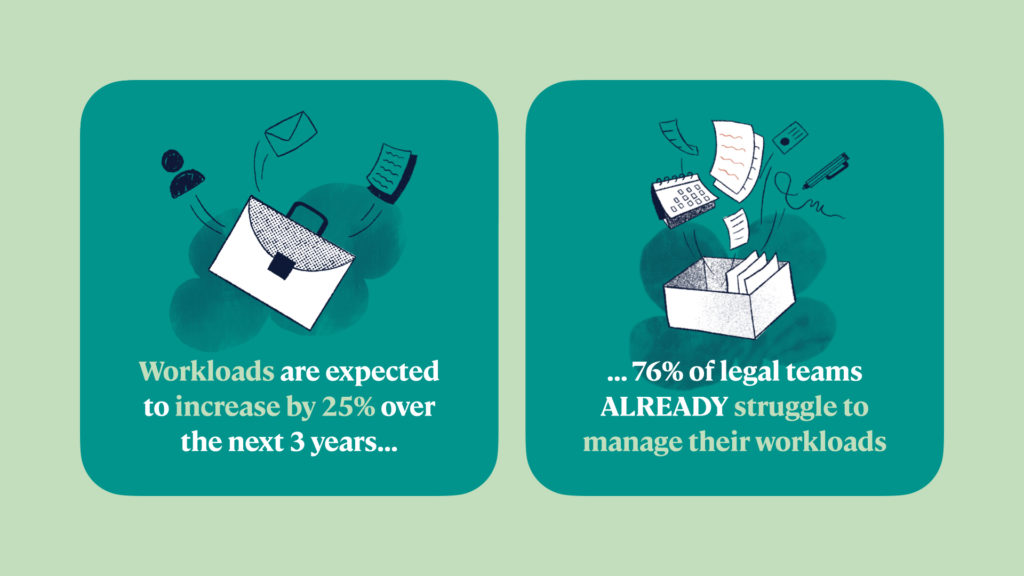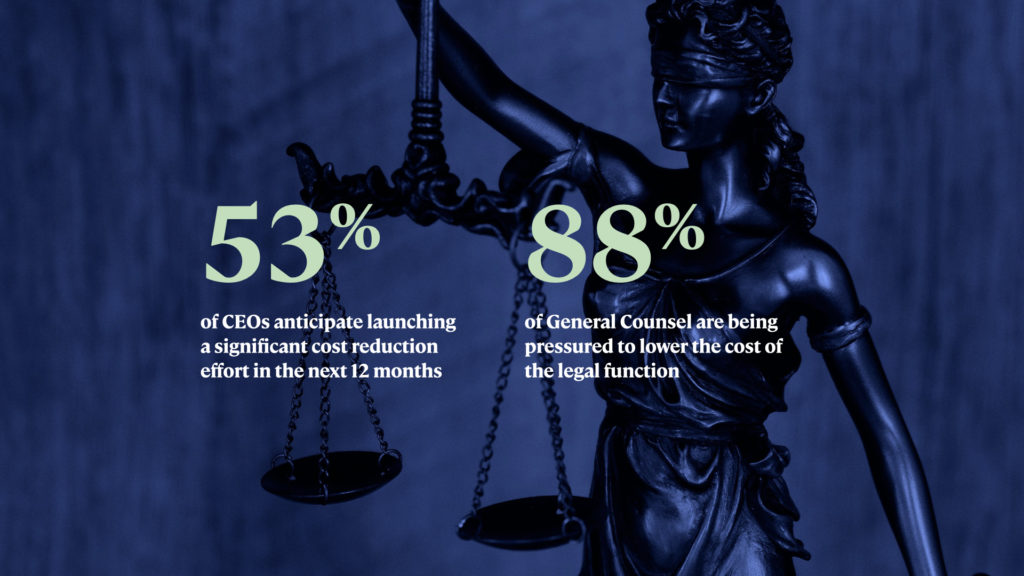To begin our journey, we’ll take a look at why legal needs to change its approach to data, and the most important thing you need to do to make your journey a success.
The latest statistics paint a possible picture of the in-house legal team’s future:
How can being a data-informed in-house legal team assist in solving these very real issues?
While statistics like these are concerning, they’re prompting in-house legal departments to search for ways of measuring their value and justifying their existence to the wider organization.


There are two sides to every story, but for the in-house legal team, one side of the story remains off the page.
If you look at other functions across a business, such as sales, marketing, and finance, the story is complete. The data used to inform decisions shows the costs and also shows the benefits.
The same isn’t really true for legal.
Legal talks about costs, but the other half of the conversation isn’t quite there; no one’s talking about the benefits of the legal team or can show the value a legal department brings to the rest of the business.
If you’re the CFO looking at a bunch of numbers on a page and trying to figure out what the story is and how savings can be made, legal seems to only speak to the cost side of the equation.
The only way to combat this is to start using data, ultimately changing the way legal speaks to the C-suite and the business as a whole.
Yet, the in-house legal team has some work to do.
We need to get to the point where there’s a solid foundation, meaning everyone understands what we do, why we do it, and build up the story from there.
Legal’s involvement in a business is often unexpected or unwanted, and often brings with it an element of friction.
To some extent, legal is essentially a reactive function – only becoming relevant when things go wrong. It’s the ambulance at the bottom of the cliff, the roadblock slowing down progress, the department of “no”.
Legal is a shield, it’s there to defend the business – and we can all understand that.
But there can be a more aspirational version to what we do, moving towards a function that’s more proactive, that understands what’s happening, that has trends, and can make decisions.
It’s about taking a seat at the top table that’s more strategic, talking with the C-suite more about where the business is going, rather than explaining what the legal department’s been up to for the past six months.
The journey legal needs to take is one that many other business functions started decades ago – the journey to using data, metrics, and analytics in a more prescriptive way.
Which brings us to the question – what can the legal industry do to raise the bar of what’s possible?
We can start by re-imagining how the future of legal looks, and what steps we need to take to get there.
The story lies within the data, it just needs to be discovered and told.
So how do we start? By finding the data.

The data that exists within a legal department is likely to be wildly unstructured. There might be some point solutions addressing a specific function; a contract management system managing contracts, an excel sheet tracking particular work types, or a CRM. But while these systems do deliver some data, there’s nothing to tie it all together and present a cohesive story.
I think it’s really obvious that as an industry we need to start building up that story.
The first step is securing a system of record.
When a VP joins a department, one of the first things they do is find out what technology is used to manage and report on the workload and activities. Otherwise, how on earth are they going to do their job?
For the rest of the business the solutions are all there – Salesforce for sales, Hubspot for marketing, Zendesk for IT… meanwhile the legal department is working out of Outlook, creating more spreadsheets, and saving documents to local drives.
While Excel can list all the activities, it’s not a relational database – there’s no link between activities, and there’s no link between functions. The relationships and correlations are just not there.
So what does this system of record look like in a legal department? Very simply, it’s a list of all the issues the legal team is involved with.
Each matter has a unique ID, and with that atomic unit you can tie anything you want to that matter, meaning you’re then able to tell its story.
If you want to know who within the legal team is doing the most work for a particular practice area, then you have all that information there in the system of record, under its matter ID, instead of the data being distributed across inboxes, spreadsheets, hard drives, or, in some cases, just not captured at all.
When the data is captured in a system of record, it’s structured, and able to be easily surfaced to be used in a more meaningful way.
The journey to a data-informed legal team starts with a system of record, captured in a matter management system.
The message we need to get across to the industry is that you need to start, from a legal-tech perspective, building out your system of record so you can start capturing data in the right ways. And drive better business outcomes.
It’s your legal team’s story, so it deserves to have the best and most comprehensive data to inform its narrative.
By telling the story of your legal team, you’re able to take a journey to a destination where data informs business decisions, moving legal to the heart of the business.
In this first part of the series, we’ve established that one system of record is the way to set your team and the business up for success. Keep an eye out for the next article in this series that’s all about recognizing the signs you’re ready to start your journey towards becoming a data-informed team, and how to actually make that all-important first step.

By clicking subscribe I acknowledge and accept the terms of the LawVu privacy policy (found here) and consent to receiving marketing emails from LawVu to stay up to date with news and events (you can unsubscribe at any time).
LawVu Head Office
26-28 Wharf Street, Tauranga 3110, New Zealand